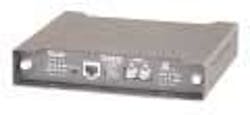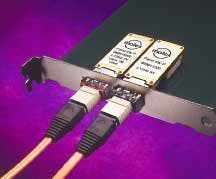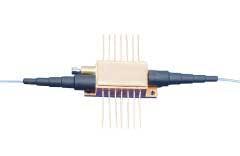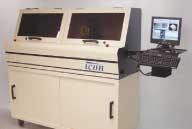Premier Products
For extreme environments, the TC3300 Gigabit Ethernet fiber-optic media converter's "industrial-hardened" version supports distances up to 100 km in temperatures from -40° to +85°C and is available with a single-fiber option. It is IEEE 802.3z/AB 1000Base-T SX and LX-compliant and converts or connects 10/100/1000Base-TX twisted-pair devices to singlemode (1300/1550-nm) or multimode (850-nm) fiber optics. Diagnostics include eight LEDs for Ethernet settings and Ethernet/power status. At a starting price of $995, the converter exceeds all pertinent utility and traffic control environmental and temperature specifications, according to the company. The TC3300 is available in two other temperature versions, -10° to +50°C and -20° to +70°C, as well as standalone or rackmount.
TC Communications, Irvine, CA
Featuring high dynamic range and flat wavelength response, the MEMS variable optical attenuator (VOA) comes as a single-channel unit or in a multichannel arrayed configuration with up to eight channels. The device is a fast, low insertion loss array of separately and continuously controlled attenuators, and the channels are adjusted by 0-5-V inputs. Based on bulk micromachining in crystalline silicon, the MEMS VOA is built using established semiconductor and MEMS processes and equipment, thus enabling integration, batch production, and high reliability.
OZ Optics, Ottawa, Ontario
The IQS-1700 power meter series now includes three new models for optical system and component manufacturing applications. A suite of next-generation, high-performance optical power meters housed inside the IQS-500 intelligent test system is available with different detector sizes and types, standard- and low-polarization sensitivity options, and ultra-high-power configurations—one, two, or four independent detectors per module. The power meter provides full high-speed auto-ranging at a sampling rate of 5 kHz, multichannel testing, low (±0.005 dB) polarization dependence, 0.0001-dB power measurement resolution, up to 40-dBm power-handling, and ease of integration with other test modules.
EXFO Electro-Optical Engineering, Quebec City
The Icon workcell integrates optical-connector polishing with inspection in a multistage platform. It fully automates connector processing from air polish through final finishing and quality testing. In-line inspection includes surface-defect analysis and interferometric measurements. The system uses connector workholders that incorporate an independent suspension design for uniform polishing with vastly extended film life. Waveguides, arrays, ferrules, and other components are also supported.
krell technologies inc., Morganville, NJ
The SST-Optimizer Cable's size has been reduced, meaning up to 72 fibers are now available in a cable with an outer diameter as small as 6 mm and a short-term tensile rating of 110 lbf. The small outer diameter makes it well-suited for microduct applications. The cable consists of bundles of color-coded fibers in a central-tube design. The single-tube design with dielectric yarns has no preferential bend, and the woven binder provides easy fiber bundle segregation and simplified fiber-handling. The craft-friendly cable construction facilitates the drop of any number of fibers at any access point and access to any individual fiber in future midspan access. As fiber demand increases, a new mini-cable can be easily installed in an additional microduct, allowing for a quick upgrade to the latest fiber technology. The 12- to 72-fiber cables also are available with a tensile rating of 300 lbf, which is fully compliant with the GR-20 standard.
Corning Cable Systems, Hickory, NC




